yogabook / asanas / maricyasana 1
Contents
maricyasana 1
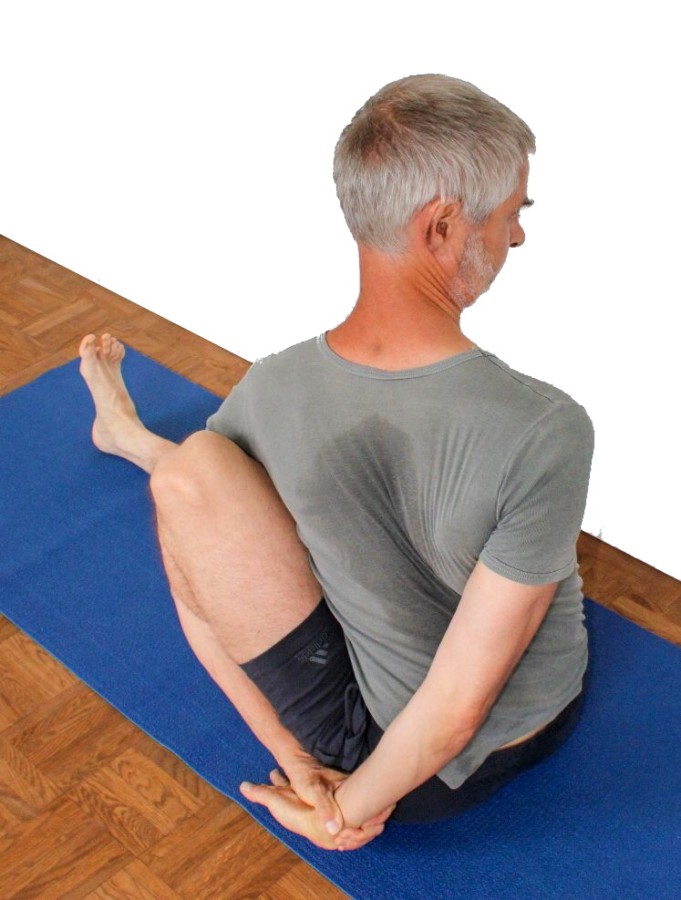
 instructions and details with working links as PDF for download/print
instructions and details with working links as PDF for download/print
Feedback: We’d love to hear what you think about this description, give us feedback at:
postmeister@yogabook.org
last update: 12/30/2018
Name: maricyasana 1
Level: A
- Classification: A
- Contraindication
- Effects of
- Preparation
- follow-up
- derived asanas
- similar asanas
- diagnostics
- Instruction
- details
- Variants
Classification
classic: sitting twist
Contraindication
Poses and movements that convexly round (flex) the spine are contraindicated in the case of herniated discs in the lumbar spine, can cause the specific pain and have a detrimental effect on the resolution of symptoms. Even if the ideal posture is an extended back, in practice the pelvis will tilt slightly backwards and the lumbar spine will round.
The pose can also cause anterior dislocation in shoulder joints that are prone to dislocate. In the case of very unstable
shoulder joints that are prone to the very seldom posterior dislocation, this pose should also be avoided.
Effects
- (212) Neck: strength for rotation
- (602) Strengthening the erector spinae
- (211) Neck: stretching for rotation
- (281) Shoulder joint: stretching for internal rotation
- (661) Stretching for rotation of the spine
- (662) Strengthening for rotation of the spine
- (712) Stretching the monoarticular/short hip extensors (especially gluteus maximus)
Preparation
Restricted flexibility of the hamstrings on the side of the extended leg causes the pelvis to tilt backwards and makes it difficult to reach around the leg, so prepare with:
- uttanasana as a generally effective and efficient stretch of the hamstrings to prepare for flexion in the hip joints in this pose
- prasarita padottanasana very similar to uttanasana
- parsvottanasana as a stretch that goes beyond uttanasana
- pascimottanasana
- janu sirsasana
- tryangamukhaikapada pascimottanasana
- downface dog as another good preparation for the hamstrings when the pelvis is tilted powerfully
- hip opener 5 as a very effective stretch of the hamstrings that goes beyond uttanasana
- warrior 3 pose
- trikonasana
- parivrtta trikonasana
Prepare to turn the upper body away from the set up leg with:
- sitting twist as a very effective and efficient exercise for twisting
- trikonasana rotation in the same direction as in maricyasana 1 in relation to the legs
- ardha chandrasana rotation in the same direction in relation to the legs
- jathara parivartanasana
In a similar way to how the pelvis tilts backwards due to flexibility restrictions of the hamstrings on the side of the extended leg, flexibility restrictions of the short extensors of the hip joint (e.g. the glutes) of the set up leg tilt the pelvis backwards, so prepare with:
- half lotus forward bend
- hip opener at the edge of the mat
- hip opener 1
- hip opener 3
- parivrtta trikonasana, with bent front leg and falling counterlateral hip
- parivrtta ardha chandrasana, with bent front knee and falling conterlateral hip
- parsvakonasana
- parivrtta parsvakonasana
The autochthonous back muscles must stretch the back with persistent strength against the pelvis tilting backwards. This can be prepared with:
- „desk“ variation of uttanasana
- rectangular uttanasana
- warrior 3 pose, also backwards against the wall
- upavista konasana in the „pull on the feet“ variant
- upavista konasana in the „with a block“ variant
- halasana
- headstand in the „lower legs bent“ variation
Both arms are in retroversion, this can also be prepared:
- purvottanasana („8 treasures“)
- shoulder stand
- setu bandha sarvangasana
- gomukhasana
- „arms behind the body“ variation of uttanasana
- „arms behind the back“ variation of prasarita padottanasana
Follow-up
You may feel tension in the middle or lower back after the pose:
- parsva uttanasana
- balasana (virasana forward bend, child’s pose)
- parsva upavista konasana
- parivrtta trikonasana
- parsvottanasana
- half lotus forward bend
- karnapidasana
- parsva ardha padmasana
Derived asanas:
Similar asanas:
Diagnostics (No.)
(246)(281) Shoulder, internally rotated retroversion:
The flexibility in terms of retroversion is dependent on the internal rotation and may already reach its limit here, but this can be significantly exceeded again if the internal rotation is removed. Both must therefore be examined individually. The anterior parts of the deltoid (pars clavicularis and acromialis), in which corresponding stretching will also be felt, are the main limiting factors.
In this forward bending movement (flexion in a hip joint), various disorders can be found:
- Shortening of the hamstrings, see FAQ.
- Damage to the hamstrings that causes pain or functional limitations can also be easily recognized here, from simple tension to strains to muscle (partial or complete) tears.
- Irritation of the sciatic nerve: irritation of the sciatic nerve, which innervates the leg and foot, can become symptomatic during forward bends in particular, even if they are otherwise rather calm. See the FAQ.
- Irritation of the origin of the hamstrings at the ischial ischial tuberosity (also known as PHT: Proximal Hamstring Tendinopathy) may become apparent in this pose, but the force applied is usually not strong enough. If it does, it requires protection before intensive stretching, see the FAQ.
- Baker’s cysts produce a feeling of tension or foreign body sensation, see FAQ.
(602) Erector spinae (autochthonous back muscles):
This pose reveals the strength endurance capacity of the erector spinae. Except in the case of good flexibility, the body’s internal resistance in the pose guarantees the need to stretch the back continuously and powerfully with the erector spinae. Any tension, whether caused by pose, professional or other demands, scoliosis, hyperkyphosis of the thoracic spine or discomfort due to misaligned vertebrae should become apparent here.
(712) Pelvic uprighting and back extension:
Lack of ability to straighten the pelvis in this pose, resulting in a round back that requires a great deal of effort to stretch (to be precise, one can often only try to prevent it from becoming even rounder) does not allow a clear conclusion to be drawn, causes may be:
- Shortening of the hamstrings, which tilts the pelvis backwards from the extended leg.
- Shortening of the short hip extensors (i.e. mainly the glutes), which tilt the pelvis backwards from the side of the set up leg.
- Lack of strength in the hip flexors, working against the two muscle groups mentioned above.
The less the pelvis is uprighted, the more difficult it is to straighten the back; the back muscles may then tire very quickly and lose performance. It is therefore also possible to make a statement about the performance of the back muscles.
Pain occurring under the wide flexion in the hip joint of the raised leg may indicate hip damage:
- Arthrotic/osteoarthritic change (degenerative with cartilage atrophy) of the joint
- Arthritis (joint inflammation) of various kinds
- Dislocation / subluxation, which would cause a significantly increased sensation of tension in various muscles covering the hip joint
- Joint trauma, which may cause pain in the joint even after many weeks or months
Variants:
Instructions
- Sit in dandasana.
- Keep the right leg stretched out on the floor.
- Draw the left foot in and place it a hand’s width away from the right thigh, as close to the pelvis as possible.
- Reach with the left hand to the outer edge of the right foot near the heel and briefly perform an intense forward bend. Then turn the upper body to the right.
- Keep the upper body as far forward as possible (in particular, the left elbow must be further forward than the left lower leg) and bring the left forearm back past the outside of the left leg, bending slightly at the elbow joint and turning further in at the shoulder joint.
- Turn the upper body as far as possible to the right, bring the right arm to the back right side of the body and with the left hand grasp the fingers of the right hand, the right hand or whatever you can grasp from the right forearm, see the details.
- Straighten the upper body again, press the left foot firmly onto the floor and continue the twist.
- When the upper body is fully rotated, turn the head in the same direction.
- If possible, press against the arm or shoulder area from behind with the left knee to rotate the upper body even further.
Details
- After the forward bend, remain upright in the pelvis for the rest of the pose and avoid arching the back, as much as possible.
- Pushing down on the left foot provides stability for the twist. Further strength for the twist can be obtained by pushing the right leg slightly to the left using the strength of the adductors. This small movement should be done against the resistance of the floor and should not lead to a cramp in the right adductor muscles, otherwise you should ease off a little. In the same way, the left foot can be pushed to the right against the resistance of the floor.
- In some cases, beginners will not be able to reach their fingers. A belt can help to mediate contact between the hands. Otherwise, the fingertips are reached first, whereby the strong pull from bending the distal finger joints can already help with the rotation. Later, it is possible to bring several phalanges on top of each other and bend them. Later still, you try to grasp the back of the hand with the left hand, then the right wrist and finally – as shown in the picture – the forearm. First the fingers of the left hand grasp the fingertips or fingers of the right hand face to face, i.e. with the flexor side, later the left hand grasps the back of the right hand, i.e. the dorsal hand, then the dorsal side of the wrist or forearm.
- A good variation is to turn the head in the opposite direction to the upper body. This has a more intensive effect on stretching some of the neck muscles. However, always make sure that the rotation of the torso remains at a maximum, as this is easily lost when concentrating on the rotation of the head in the opposite direction.
- Try to implement the three parameters relevant for an upright posture:
- Raise the iliac crest, i.e. upright the pelvis.
- Lift the sternum, i.e. stretch the upper body.
- Raise the back of your head, i.e. do not let your head fall back, but instead stretch it straight up.
- It may be quite difficult for less agile people to take this pose. Stiffness of the torso or shoulders, as well as the hip joints, can prevent the hands from being brought together behind the back. The first prerequisite for this, and therefore essential for the pose, is that the right elbow can be brought forward a little beyond the left lower leg. A stiff torso and stiff hip joints or glutes can prevent this.
- The following trick can be used to better grip the leg with the arm: place the upper arm as if you wanted to grip the leg. If the elbow is not significantly further forward than the lower leg, it would be almost impossible to bend the arm around the leg. Then grasp the upper arm with the inner edge of the other hand so that the outer edge of the hand rests on the lower leg and the elbow is pulled further forwards and downwards by supinating the forearm. In many cases, this makes it possible to take the pose.
- On the side of the free arm (the one that is not gripping the leg), the retraction of the shoulder blade – in contrast to the other side, on which the gripped leg prevents this – is at a maximum, which leads to a feeling of compressed muscles that may be cramping, but rarely actually cramp, particularly in the area of the inner lower edge of the shoulder blade.
- In cases where the shoulders are less mobile, there is an intense stretching of the anterior parts of the deltoid. This sensation can be even greater on the side of the gripped leg because the arm has to turn in more. In principle, however, the sensation is possible on both sides.
- If a belt is used to bridge the distance between the hands, the free hand on the belt pulls the hand gripping the leg, as this is usually where the greater difficulties lie, which is also due to the greater internal rotation requirement of the arm.
Known problems that can occur even when performed correctly
Feeling of excessive strain on the back muscles
See above
Cramp in the rectus femoris of the raised leg
The tendency to cramp can occur when the muscle is also used to upright the pelvis. Although the knee joint is flexed so that the muscle does not work in an extremely short sarcomere length, the flexion in the hip joint outweighs the relieving flexion in the knee joint, so that the working range of the rectus femoris is not very favorable and a tendency to cramp can occur.
Compressed, cramp-like sensation between the inner edge of the shoulder blade and the spine
See above; this feeling rarely leads to real cramps
Variants
With belt
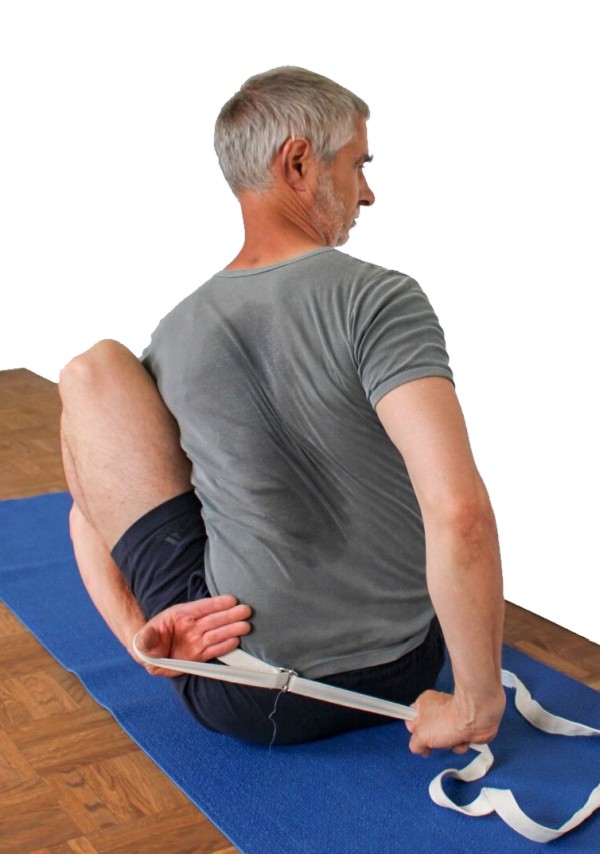
Instructions
- Perform the pose as described above, but if it is not possible to reach the fingers of the right hand with the fingers of the left hand, use a belt that is gripped by both hands and on which the free hand pulls the hand gripping the leg backwards and downwards.
Details
- Which arm pulls the other is determined by the demands on the arms: in the arm gripping the leg, the internal rotation requirement, which is not easy for many people to fulfill, is greater, so its hand is pulled further into the pose by the other.
(P)

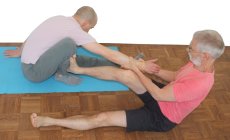 | 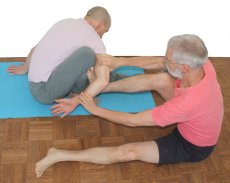 | 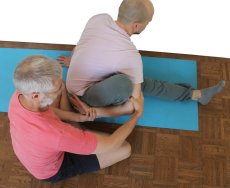 | 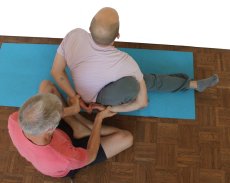 |
Instructions
- Take the pose as described above, but the supporter intervenes during the set-up and in the pose:
- When setting up the pose, the elbow of the arm that will later embrace the leg must be able to move recognizably further forward than the lower leg on the same side. The supporter grasps the outstretched arm and pulls it forwards and downwards. The upper body of the performer must already be rotated to the maximum so that the corresponding shoulder can move forward as far as possible. If the criterion that the elbow is in front of the lower leg is met, this is an important prerequisite for the pose, which does not yet mean that it is possible. The available internal rotation of the arm may still be too limited to reach around the leg.
- During the execution, the supporter can give the performer the belt to pull on during the pose. The supporter can also turn the performer further into the pose by the shoulders.
Details
- Maricyasana 3 is considerably more difficult than maricyasana 1, depending on the flexibility of the upper body and hips, but success here also depends on the flexibility of the shoulders, upper body and hips. The shoulder joint requires a certain degree of retroversion of the arm and of internal rotation. The muscles of the hip joint must allow a pronounced flexion and the upper body must be able to rotate well. The supporter can assist with all of these movements by pulling the arm that is to grip the leg forwards forcefully, but of course not jerkily, while pushing the performer’s lower leg towards the upper body and into the armpit with one foot. If the elbow of the same arm then reaches a clear distance in front of the lower leg, there is a good chance that the arm can grip the leg. This does not yet indicate whether the hands can meet on the back, but it is a necessary condition for this. It is helpful if the supporter releases the pressure of his foot at the earliest when the arm has reached around the leg. To achieve this, the supporter turns the upper arm in with one hand and holds it as low as possible, with the other hand he guides the lower arm around the lower leg, bending the elbow joint accordingly.
- Note that the elbow joint can only be bent in the desired direction and the forearm can only be moved backwards if the arm is turned sufficiently far into the shoulder joint. If the fingers cannot meet on the back, the supporter gives the performer a belt so that via the belt the free hand can pull the hand gripping the leg.
